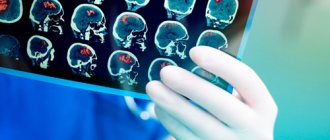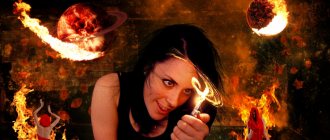A nervous tic is a sudden, repetitive movement that occurs as a result of involuntary contraction of a specific muscle group. For example, it is often said that “the eye twitches.” Twitching can affect different muscles, spread from one muscle group to another, and even cover almost the entire body.
Movements during tics are obsessive and a person cannot control them. When you try to suppress a tic, the tension increases and as a result the tic only gets worse.
The most common tic occurs in childhood, and it is detected somewhat more often in boys than in girls. It is believed that tics occur in 13% of boys and 11% of girls.
Causes of nervous tics
The causes of tics are usually grouped as follows:
- primary tics
caused by psychogenic factors. In this case, there are no organic pathologies. The occurrence of a tic can be caused by stress, fear, depression, and neurosis. It is this type of tics that most often occurs in children. The cause of a nervous tic in a child can be psycho-emotional trauma, increased anxiety, obsessive fear, attention deficit hyperactivity disorder (ADHD); - secondary tics
. In this case, the tic is a consequence of any diseases that cause disruption of brain activity. These may be infectious diseases (encephalitis), intoxication, brain injury, cerebrovascular accidents; - hereditary tics.
Shakes violently after drinking alcohol: why does this happen?
After a heavy drinking session in the morning, not only the upper limbs may tremble, but also a feeling of severe anxiety may arise - in medicine, such a condition is called tremor.
Alcohol tremors after drinking alcohol-containing drinks are the result of the effect of ethanol on the human body. The oxidation of ethyl alcohol contained in any strong drink saturates the blood and important organs with a dangerous substance - acetaldehyde. Its increased concentration affects both the brain and spinal cord, causing severe poisoning, trembling of the limbs, disorientation in space and hallucinations.
If the tremor is observed in the morning and disappears within 3-4 hours along with other signs of a hangover, then there is no need to worry too much. But if, after drinking alcohol, your whole body shakes and does not disappear throughout the day, while you have a low-grade fever and a splitting headache, then you need to contact a specialist. This condition may be a sign of severe alcohol poisoning or the development of an allergic reaction to the components of an ethanol-containing drink.
In addition to frequent drinking or binge drinking, a one-time intake of ethyl alcohol, contained in all alcoholic beverages, can also be a factor in the occurrence of tremor. This happens due to a person’s lack of habit of drinking alcohol, which leads to large tremors of a larger muscle group and a feeling of anxiety. Also, tremors and chills can occur not only due to drinking alcohol, but also due to severe fatigue, poisoning, Parkinson's disease or hypothermia. It is important to remember that drinking alcohol in these situations will only worsen an already deplorable situation.
Symptoms of a nervous tic
Involuntary movements can affect only one muscle group - such tics are called local
.
There are also simple and complex tics. A simple tic is a complex of the simplest movements of the same type. With a complex tic, involuntary movements affect several muscle groups. A severe type of the disease is a generalized tic
, affecting almost the entire body. With this type of tic, involuntary movements usually begin in the face, then involve the muscles of the neck, shoulders, arms, chest, abdomen and back, and even legs.
Most often, tics affect the facial muscles. In this case, such movements as blinking, moving the lips, opening the mouth, moving the eyebrows, and twitching the nose are characteristic. When a tic spreads to the neck and shoulders, nodding and shaking of the head are typical. Tic spreading to the limbs is expressed in the form of flapping of arms, clapping of palms, stamping and jumping.
A group of vocal manifestations is also distinguished. In this case, screams, coughing, howling, uttering curses, and incoherent speech may be observed.
What to do if you feel faint: first aid
All first aid techniques during a pre-fainting state are aimed at preventing the onset of full-fledged fainting. Let's look at all the necessary steps in detail.
- The first is to provide oxygen access to the room, and, if possible, take a comfortable position. Remove all objects that put pressure on the chest and neck (scarf, tight collar, tie). To better saturate the blood with oxygen, it is necessary to take rhythmic inhalations and exhalations. If the breathing process is difficult, ammonia will help. A sweet, warm drink in the form of tea also helps relieve an attack. If you suspect evaporation of harmful substances in the room or a gas leak, you should quickly leave the building and go outside.
- After the crisis has passed, the body must be provided with the required amount of fluid, which involves consuming at least 2.5 liters of water per day. Taking drugs such as Asparkam and Panangin will normalize the balance of electrolytes in the blood and ensure normal blood supply to all organs. And, of course, it is necessary to establish the cause of the pathology.
- If you have chronic fatigue syndrome, you must take the necessary vitamins and minerals and ensure all conditions for normal work and rest. In case of hypotension or anemia, the cause of this condition should be immediately determined. Since some pathologies require immediate medical attention.
Everything we talked about in this article needs to be known and remembered by every person. Because presyncope attacks develop suddenly, which can pose a serious threat to life. After all, at this moment a person can cross the roadway or drive a car. The most important thing when providing first aid to yourself or your loved ones is to prevent full-blown fainting from developing.
Primary appointment with a neurologist: 1850 RUR.
Sign up Online 5% discount when registering from the site
When should you see a doctor if you have a tic?
Every person can experience involuntary muscle contractions under great emotional stress (for example, eyelid twitching). If such manifestations are observed within 2 weeks (including repeated single tics), then this is already a disease. Tics that last less than a year are called transient (temporary). If a tic persists for more than a year, it is called chronic. Simple transient tics usually go away on their own. However, it is still necessary to see a doctor to reduce the risk of the tic becoming stronger and stronger.
Most common causes of chills
The first thought that appears in a person who notices a headache, chills and weakness is that he has an acute respiratory viral infection or the flu. The patient's body has to produce a large amount of heat, so in most cases the temperature rises in such patients. These symptoms may be accompanied by a runny nose, headache, aching bones and other signs of illness. Under no circumstances should you suffer from discomfort on your legs! Seek medical help and start treatment as soon as possible.
Often the feeling of cold in people with a hypersensitive nervous system is accompanied by severe anxiety. In addition, this may be a consequence of fright. This is a temporary symptom - as soon as a person manages to relax and calm down, he stops freezing. In many cases, chills without fever are a common companion for those people whose working blood pressure is below normal. In addition, in women, the cause of chills can be the first days of the menstrual cycle, as well as the beginning of pregnancy.
Often the cause of chills is all sorts of disturbances in the patient’s peripheral circulation. Especially many of these people live in regions where damp, cold weather is the norm. In such patients, the blood supply to the fingers of the upper and lower extremities is reduced. This can be visually determined by redness and swelling of the skin. Symptoms include severe itching.
People who have been diagnosed with diabetes mellitus are familiar first-hand with the unpleasant sensations that accompany chills. In addition, this symptom may indicate that the patient has other types of endocrine diseases. For example, in patients with insufficient thyroid function, the following symptoms may be associated with chills and headaches:
- hair loss up to baldness;
- a sharp increase in body weight up to obesity;
- mood swings from complete euphoria to hysteria and depression;
- excessively dry skin on the face and body;
- weakness, drowsiness, decreased performance, etc.
The feeling of cold is associated with insufficient production of hormones by the gland, which results in impaired thermoregulation. In addition, similar symptoms are often observed in women aged 50 years and older. This is associated with menopause.
Finally, patients with VSD often suffer from chills and weakness. They can be cold even in July, when everyone is wearing light dresses, shorts, T-shirts and flip-flops. The fact is that people suffering from vegetative-vascular dystonia may have seriously impaired thermoregulation. Such patients need to visit saunas and baths more often, and also start each morning with a contrast shower. During the cold season, swimming in an ice hole can help them strengthen blood vessels and improve thermoregulation. Finally, a massage course conducted by a qualified specialist can play the role of an “ambulance” for such people and temporarily relieve them of chills.
Please note that the above methods of healing the body are not suitable for people suffering from cardiovascular diseases.
Treatment of nervous tics
Nervous tics are treated by a neurologist. In case of primary tic, a psychotherapist can help. Primary tics in children usually go away with age. To relieve symptoms and speed up recovery, it is recommended:
- normalization and adherence to the daily routine. It is necessary to get up, eat and go to bed at approximately the same time;
- proper and balanced nutrition;
- active lifestyle, sports, walks in the fresh air;
- eliminating excessive mental stress;
- reduction of psycho-emotional stress. Normalization of relationships in the family, and for the child also at school, is of great importance.
If tic manifestations are severe, the doctor may prescribe medication. For secondary tics, treatment is primarily aimed at combating the underlying disease that caused the tic. In most cases, with successful treatment of the underlying disease, the tic disappears.
Massage and reflexology are also used to treat tics.
How to get rid of hand tremors
Depending on the type of tremor, there are various treatment methods; below are general tips for getting rid of this ailment:
- Reduce your stress levels. Make a plan to avoid conflict situations and not fall out of balance. Try to master breathing techniques, meditation, and if necessary, consult a psychotherapist.
- Start taking sedatives. You should not select strong medications on your own; only a specialist can prescribe them. Consider plant-based sedatives.
- Try to drink less coffee and energy drinks, they seriously weaken the nervous system.
- A stable daily routine and normal sleep patterns help normalize the condition.
- Give up bad habits such as alcohol and smoking.
- During an attack of tremor, pick up something heavy, unless there is a physical reason for the occurrence.
- If you are undergoing treatment, check with your specialist about any side effects that may cause tremors.
- Do not self-medicate.
A feeling of shaking and vibration often accompanies
- muscle tension
- difficulty concentrating
- increased heart rate
- extrasystoles
- uncontrollable shaking
- feeling of fear
- fatigue and muscle pain
- headache or migraine
- nausea, vomiting, or loss of appetite
- rapid breathing
- excessive sweating
- feeling of tension, irritability
What to do if there is a feeling of trembling or vibration in the body
The sensations of trembling, vibration, and buzzing that are caused by anxiety are not dangerous. Other accompanying sensations will not cause harm. However, they can significantly reduce a person’s quality of life and create discomfort. Sometimes such symptoms can lead to a loss of control over one's own body. In impressionable people, such sensations can often develop into panic disorder.
Therefore, based on many years of experience, we highly recommend. If you begin to feel trembling, vibrations in the body or its individual parts, at some specific moments. Perhaps these sensations do not let you go throughout the day. Don't start panicking.
It is necessary to contact the specialists of our clinic as soon as possible. We will be able to conduct a special diagnosis of the nervous system, accurately determine the true causes of the sensation of yeast or vibrations and carry out the necessary therapy.
Types of hyperkinesis
There are various criteria that are used to classify pathology. Thanks to them, the following types of hyperkinesis can be distinguished:
- childhood forms - hyperkinesis up to one year, in the age category from one to five, during puberty;
- by type of occurrence - spontaneous, reflex (reaction to external phenomena), actional (provoked by a certain condition), induced (can be controlled by the patient);
- along the flow – constant (tremors) and episodic (tics);
- by speed of movement - fast and slow;
- by localization - hyperkinesis of the face, limbs, tongue;
- by origin - a distinction is made between primary (congenital) and secondary hyperkinesis acquired as a result of injury or taking medications.
Hyperkinesis in cerebral palsy in children begins to appear at the age of 1.5-2 years. Children with this pathology have difficulty coordinating their movements, which often look like pushing, jerking and twisting. Repetitive movements can be fast and rhythmic or, conversely, slow and erratic.
Hyperkinesis in cerebral palsy may be accompanied by swallowing disorders, speech delays and disorders, and lability of the emotional system.
Psychotherapy for feelings of trembling and vibrations in the body
Most often, people begin to resort to the help of psychologists and psychotherapy. Psychotherapy explains to a person the true origin of these sensations. This understanding often temporarily reduces the urgency of the problem and symptoms decrease. However, even if you realize that all these problems appear only in your mind and they have nothing to do with your physical health, the disease itself will not go away. It will dull temporarily, but with any, even minor stress or physical activity, it will begin to return.
How to properly deal with the feeling of trembling and vibration in the body
In order to reliably overcome the sensations of trembling or vibrations in the body, it is necessary to understand that under the influence of external unfavorable influences on the nervous system, a failure of the metabolic processes of the brain has occurred. In order to restore these processes, special drugs are required.
We use special complex therapy, which includes neurometabolic therapy, which restores biological processes, and special medical psychotherapy, which helps the nervous system restore normal mental reactions.
The set of measures also includes an individual approach to each person, as this is associated with differences not only in the body’s metabolic processes, but also in differences in the pattern of mental reactions. Each person requires the development of an individual therapeutic plan.
Diagnostics
The causes of chills with or without fever are determined by the local physician, who draws up a plan for the initial examination and, if necessary, refers the patient for consultation to other specialists. The diagnostic search involves excluding the most common etiological factors of chilling, for which instrumental and laboratory tests are used. The most informative methods are:
- Blood analysis
. All subjects with chills for no apparent reason have a general blood test taken, which shows signs of inflammation or bleeding. A biochemical study reveals symptoms of damage to internal organs, primarily the liver. The levels of thyroid and adrenal hormones are determined. - Bacteriological method
. If chilling is accompanied by a runny nose, cough, and symptoms of gastrointestinal damage, it is necessary to collect appropriate biological material for microscopy and culture on selective nutrient media. If signs of night chills persist for a long time, three-time examination of sputum for tuberculosis is informative. - Neurological examination
. Chills without fever are often a symptom of disorders of autonomic innervation, for the diagnosis of which special tests are used: orthostatic, Danini-Aschner. To exclude severe neurological disorders, the symmetry and integrity of basic reflexes, muscle tone and coordination of movements are checked. - Ultrasound diagnostics
. Periodic complaints of chills without an increase in body temperature are an indication for an ultrasound of the thyroid gland. The method makes it possible to identify space-occupying formations and diffuse replacement of parenchyma with lymphoid or connective tissue. An ultrasound of the abdominal organs is also performed, with special attention paid to the adrenal glands. - X-ray imaging
. When chilling is combined with possible damage to internal organs, a plain radiography of the abdominal cavity and a radiograph of the lungs in two projections are recommended. In case of constant chills of the whole body for no reason, highly sensitive thyroid scintigraphy is prescribed. - Additional Research
. Serological tests (RIF, ELISA, PCR) are performed for rapid diagnosis of viral infections. To exclude a gynecological cause of severe chills in a woman, the vagina and cervix are examined in a speculum and smears are taken. Patients with exudative diathesis are prescribed an extended immunogram study.
Balance and coordination problems
Impaired coordination of movement is called “ataxia” by the medical term. This condition is a sign of a process that was triggered by problems in the functioning and distribution of nerve impulses sent from the brain.
To carry out effective treatment, it is necessary to conduct a comprehensive diagnosis and eliminate the factors that initially influenced the process of human brain activity. Self-medication in such a situation is impossible and unacceptable. This is because serious consequences such as disability or death are possible.
The musculoskeletal system is subject to control by the nervous system. Neurons located in the spinal cord and brain are interconnected. Thanks to their coordinated work, a signal is transmitted to the main human organ. From there comes a response impulse that provokes action.
When neurons from different areas work correctly, the signal is clear and lightning fast. If there are problems in any part, the impulse is supplied slowly or is absent altogether. The disturbance is called loss of motor coordination.
Most often, the disease occurs in older people who have crossed the 60-year threshold, regardless of whether they are men or women. The reason for the occurrence, first of all, is the aging of the body and the inability to clearly and fully carry out assigned tasks. The disease can develop not only in adults, but also in children.
Species and types
There are static and dynamic violations. In the first case, problems with coordination arise only when the person is vertical, when the patient is standing. In the second situation, incoordination appears with any movement.
The following types of ataxia are diagnosed:
- Posterior columnar (sensitive) - develops with damage to the spinal and peripheral nerves, as well as the thalamus and posterior columns of the spinal cord. Movement is difficult; when walking, the patient does not feel a hard surface underneath him or his own actions. The cause is changes in the sensitivity of the muscular-articular system.
- Cerebellar - manifests itself due to damage to the cerebellar system. It is divided into 2 types: dynamic or static-locomotor. In the first type, the functioning of the cerebellar hemispheres is disrupted. The person makes frequent chaotic movements, there is uncoordination, trembling of the arms and legs, and a speech disorder is detected. The second type is characterized by damage to the cerebellar vermis. The patient has an unsteady gait, he staggers and spreads his legs when walking. In severe cases, the support of the head is disrupted and keeping it in one position becomes impossible.
- Vestibular – disorders occur in the vestibular apparatus. The head is constantly dizzy, the condition is accompanied by nausea and vomiting. When changing position or sudden movement, the symptoms worsen.
- Cortical - the problem occurs in the cortex in the frontal lobe in the anterior regions. Impulses from this part are directed to the cerebellum. There is a change in gait, unsteadiness and uncertainty when walking. The human body deviates in different directions, the feet are aligned in one straight line, and legs become entangled.
To correctly diagnose the type of disease, the factors of its occurrence are first identified. Based on these data, the patient is prescribed therapy. To eliminate the problem, you need to know exactly the causes of poor coordination when walking.
Causes of the disease
The movement problem is dangerous and serious for a patient with disabilities. Being in this state, a person is unable to coordinate his own actions.
The development of the disease is influenced by many factors. The following reasons are identified:
- Traumatic brain injury
- Brain neoplasms
- Parkinson's disease
- Encephalopathy
- Dorsopathies
- Stroke
- Cerebral palsy
- Intoxication due to improper use of medications
- Gas poisoning
- Autoimmune diseases
- Sclerotic changes in old age
- Infectious diseases: meningitis, encephalitis
- Taking drugs
- Catalepsy is muscle relaxation due to a surge of emotions.
It is not difficult to identify the disease; the symptoms are visible to the naked eye. But to know exactly what they are, you need to familiarize yourself with the clinical picture.
Symptoms of manifestation
People with a developing disease move poorly, are unsure, lack balance, appear distracted, and have impaired articulation. When trying to draw a figure, for example, a circle, in the air, the patient ends up with a zigzag or broken line.
One method of testing coordination is a test where the patient is asked to touch his nose. If the disease develops, a person cannot perform the assigned task normally. The patient gets it either in the mouth or in the eye. Negative changes are also visible in the handwriting: the letters are written unevenly, creep on top of each other, and jump along the line. These signs indicate neurological problems.
When coordination is impaired, the following symptoms appear:
- The pupil perceives the present as an illusion, objects are constantly in motion or rotation;
- The gait changes, there are frequent falls;
- High blood pressure is recorded, hypertension is detected;
- The patient becomes lethargic, drowsiness appears or sleep is disturbed;
- There is a malfunction in the functioning of the hearing organs: sometimes noises are heard, sometimes sudden silence;
- There is tremor of the limbs;
- There is a loss of clarity and coherence of movements;
- There are headaches for no apparent reason and severe dizziness;
- Irregular breathing, shortness of breath, increased sweating;
- Psychoneurological disorders occur - delusions, hallucinations.
Regardless of what symptom is present, you should immediately consult a doctor. The doctor assesses the patient’s condition and accurately establishes a diagnosis, on the basis of which a therapeutic intervention is prescribed. Early detection of disturbances in motor coordination leads to a reduction in symptoms and short-term therapy.
Treatment of ataxia
To accurately identify the disease that the patient suffers from, the doctor records complaints, conducts an external examination and tests. To make an accurate diagnosis, it is necessary to undergo a certain examination:
- Biochemical blood test in expanded form;
- Magnetic resonance and computed tomography;
- General urine and blood tests;
- Ultrasound examination of internal organs.
Depending on the patient’s complaints, the diagnosis is adjusted, and the range of necessary tests is expanded. Based on the results obtained, the doctor tells you how and why you need treatment.
To treat impaired motor coordination, an integrated approach is used, which includes drug therapy, as well as, if contraindications are excluded, rehabilitation. The following medications are used for therapy:
- Nootropics and angioprotectors;
- Vitamins B, A, C, B12;
- Antibiotics to treat existing infection in the brain or middle ear;
- Medicines that activate cellular metabolism.
All medications are prescribed by the doctor for the patient on an individual basis.
A number of exercises have been developed to restore balance, as well as to prevent their occurrence:
- When traveling on public transport, it is better not to sit down, but to remain standing. The legs are spread shoulder-width apart, you need to refrain from supporting. Try to coordinate your movements while balancing on weight;
- Place your feet together, spread your arms in different directions, close your eyes. You need to hold this position for 20 seconds. Then lower your hands and repeat the procedure again;
- It is required to take long walks every day, taking walks. You need to walk along a narrow curb without the help of others. This exercise can be done at home. To do this, you need to draw a line or lay out a board and try to walk smoothly along the marked surface;
- Exercise with stairs. You have to climb up and down the rungs several times throughout the day.
- Both feet are placed on the same line, so that the toe rests on the heel of the other. Hands spread in different directions. You need to stand like this for 15-20 seconds, then change position.
Thanks to daily exercises, all systems are gradually brought back to normal. Drug therapy additionally affects internal organs and normalizes blood circulation. This allows you to quickly treat the acquired disease.
Thus, impaired coordination of movement is a pathological process that occurs due to malfunctions of the nervous system. The symptoms of the disease are obvious, so you should not delay treatment. Correctly and daily exercises, as well as taking recommended medications, can quickly restore the patient’s condition.










